
- Home
- CALENDAR of Shows & Events
- Education Resources
- Eclipses
- Citizen CATE Experiment
- Eclipse Activities
- Eclipse Animations
- Eclipse Equipment
- Eclipse Graphics
- Eclipse Media Coverage
- Eclipse Resources
- Eclipse Show "TOTALITY!"
- Eclipse Timeline
- Eclipse Training
- Lunar Eclipse FAQ
- Solar Eclipse FAQ
- Safe Eclipse Observing
- TicTacToe Game
- Past Eclipses
- Eclipse 2024
- Eclipse 2017
- May 26, 2021 [Total]
- June 10, 2021 [Annular]
- Mars
- Moon
- Apollo Anniversary
- Apollo Animations
- Artemis Animations
- Sundials
- Video Lectures
- Mailing Lists
- Outreach Programs
- Citizen CATE Experiment
- HEAT
- Software Training
- Current
- MMS Outreach
- Reach For The Stars! Festival
- 2025 Festival Info
- RFTS Exhibitors
- RFTS Archive
- Rice / HMNS Partnership "Firsts"
- Rice Campus Observatory
- W5YG - Ham Radio Club
- Previous
- CLUSTER Outreach
- CUWiP Meeting 2017
- Future Space
- IAO
- IMAGE Outreach
- Programs for Teachers
- MST Program
- Space Weather
- Space Weather : Forecast
- Space Weather : Realtime
- Space Weather : Resources
- Space Science at Rice
- SPAC Alumni
- Rice Physics & Astronomy
- Rice Space Institute
Contact Information
Dr. Patricia Reiff | reiff@rice.edu
(713) 348-4634
Rice Space Institute, MS-108
Rice University
6100 Main Street
Houston, TX 77005-1892
Solar Eclipse FAQ
Courtesy Prof. Patricia Reiff, the Rice Space Institute
- Why does a solar eclipse only happen during new moon?
- Why don't we have a solar eclipse every month?
- What is the difference between a partial solar eclipse and a total solar eclipse?
- When is the next solar eclipse?
- Does the time of the eclipse depend on where on Earth I am?
- What is an "annular" eclipse?
- What would you see if you were standing on the Moon when the Earth experiences a total solar eclipse?
- Why is a total eclipse so much more special than a partial or annular eclipse?
- Are all total eclipses the same?
- Are solar eclipses safe to view with the naked eye?
- Where should I go to see a total eclipse?
1. Why does a solar eclipse only happen during new moon?
Only during full moon and new moon is the Moon in a line with the Earth and Sun. If the Earth is in the middle, the Moon is ʻfullʼ and fully lit by the sun. Only then, if the alignment is perfect, we get lunar eclipses [the Earth's shadow falling on the Moon]; if the Moon is in the middle, the Moon is ʻnewʼ (we see only the dark side) and, if the alignment is perfect, we get solar eclipses [the Moon's shadow falling on the Earth].

2. Why don't we have a solar eclipse every month?
The plane of the Moon's orbit around the Earth is not exactly the same as the plane of the Earth's orbit around the Sun, so the Moon (as seen from the Earth) generally passes over or under the Sun during times of new Moon. Only twice a year, when the orbits cross, at the "nodes", are eclipses possible, called "eclipse seasons"; even then, the Moon also has to be in the right place in its orbit to yield an eclipse. There will generally be at least one partial solar eclipse each year, but there can be more. If there is a total solar eclipse that season, then there must be at least a partial lunar eclipse two weeks earlier or two weeks later.
3. What is the difference between a partial solar eclipse and a total solar eclipse?
In a partial eclipse, the sun is only partially covered by the Moon, so the viewer is in the penumbra - the shadow of the moon that is not so deep. In that case, you don't get to see the Sun's corona (which is only visible during totality). Even in a total eclipse, there is about an hour of "partial phase" (as more and more of the Sun is being progressively covered) before the totality (which only lasts for a few seconds to a few minutes), and then another partial phase as the Moon continues its motion and uncovers the Sun again. The moon moves about 12 degrees a day through the sky, so it takes an hour to move its angular diameter (about a half-degree).
4. When is the next solar eclipse?
- Find out the next lunar or solar eclipse at your location here: https://TimeAndDate.com/eclipse
- Another great place is Goddard Space Flight Center https://eclipse.gsfc.nasa.gov/solar.html.
- Xavier Jubier maintains an excellent eclipse site with maps at http://xjubier.free.fr/en/site_pages/Solar_Eclipses.html.
In the continental US we will have total solar eclipses in 2024 and 2045 (see image at GSFC) and annular eclipses in 2023, 2046 and 2048, plus partial eclipses. However, there are total eclipses visible somewhere on Earth at least every other year. To calculate the eclipses near you, NASA created a javascript eclipse calculator - just enter the latitude and longitude and it will give you the times and percent coverage of the Sun for any location on Earth.
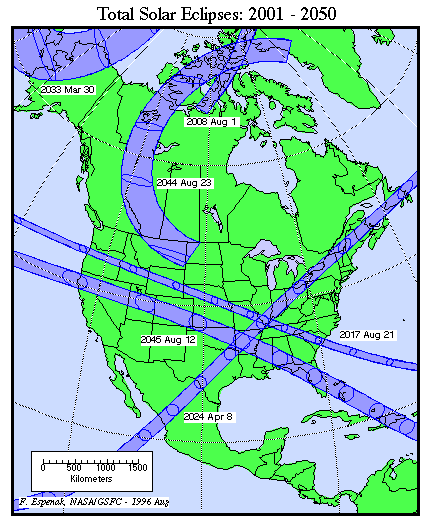
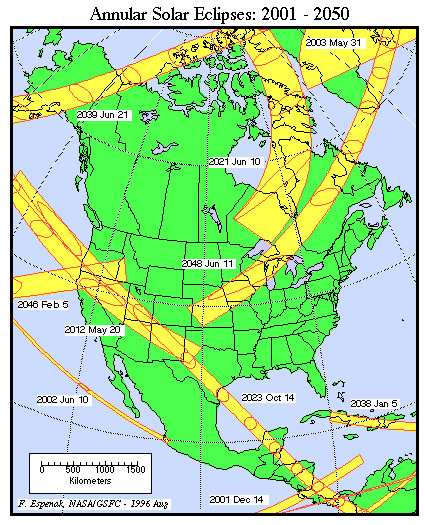
5. Does the time of the eclipse depend on where on Earth I am?
Definitely! Since the Moon is relatively small and far away, only a narrow stripe across the Earth will be in the umbra, the part of the Moon's shadow with the Sun completely covered. The people near that, but outside the "path of totality", will only see a partial eclipse. The shadow travels across space very fast, at the speed of the Moon's orbit around the Earth (2288 mph, or 3683 km per hour, generally from West toe Earth), but the Earth itself is also rotating (about 1000 mph at the equator), so the effective speed across the surface is less and varies with each eclipse, but always more than 1000 mph. So it takes a few hours for the eclipse to cross the Earth's surface. For eclipses which occur near noon local time, the approach of the column of the "Moon shadow" is very dramatic! Some, however, will miss the beginning of the eclipse because it starts before their sunrise, or miss the end of the eclipse because it ends after their sunset.
6. What is an "annular" eclipse?
On average, the Moon is actually a little too small to completely cover the Sun. The Moon's angular size in the sky varies by 5.5% because its orbit around the Earth is actually an ellipse. Similarly, the Sun's angular size in the sky varies by about 1.7% because the Earth's orbit is an ellipse, also. When the Moon is closer than average, or the Sun is farther than average, we get total eclipses. When the Moon is farther than average or the Sun is closer than average, we get "annular" eclipses. In that case, even though the Moon is in perfect alignment, there is still a ring of sunlight visible - the annulus. Annular eclipses are not safe to view with the naked eye or with telescopes without special protection.

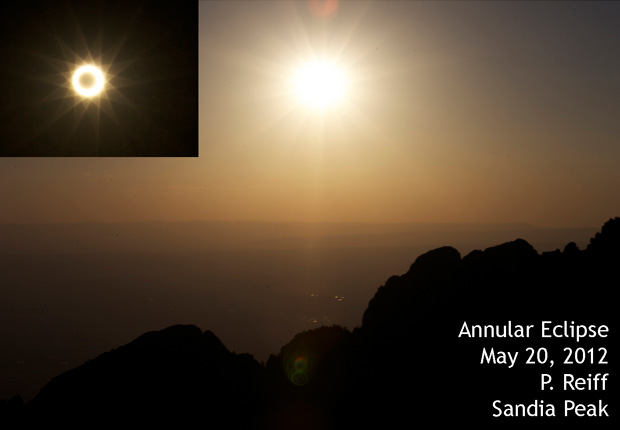
7. What would you see if you were standing on the Moon when the Earth experiences a total solar eclipse?
From the Moon, you can see the Moon's shadow crossing the Earth. This is the story of our planetarium show Earth's Wild Ride that you can watch free from our ePlanetarium website. Below is a photo from the Mir spacecraft for the 1999 eclipse.
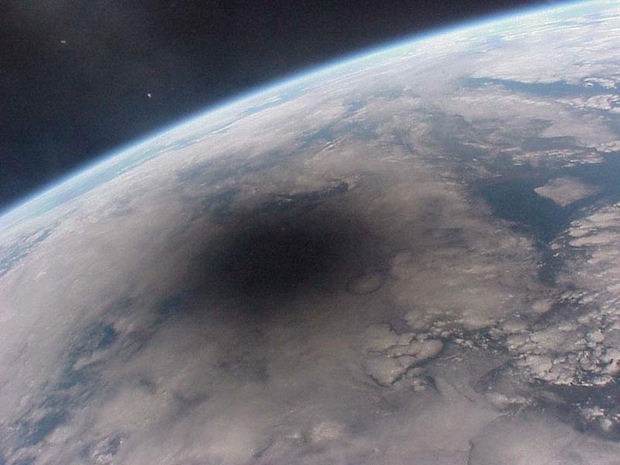
8. Why is a total eclipse so much more special than a partial or annular eclipse?
Only for the fortunate few in the path of totality will the Moon cover all of the bright part of the Sun, allowing the "corona", the glowing halo, to show through. It is not visible in partial eclipses (even 95%!) or in annular eclipses, because the sun is so very bright. Spacecraft can make artificial eclipses in space because there is no atmosphere to scatter the bright light of the Sun. Another gorgeous part of of a total eclipse is the "diamond ring" when only a tiny part of the sun is not covered. The diamond ring photos below are from Max Garrick in 2010 Polynesia, and from Brian Verkaart in Australia in 2012.
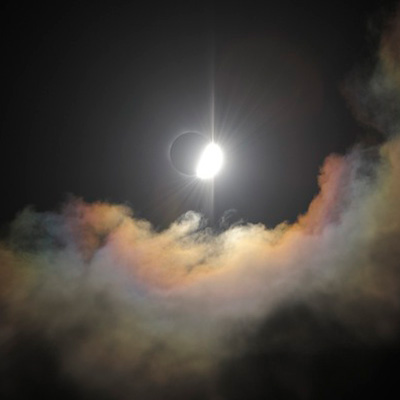
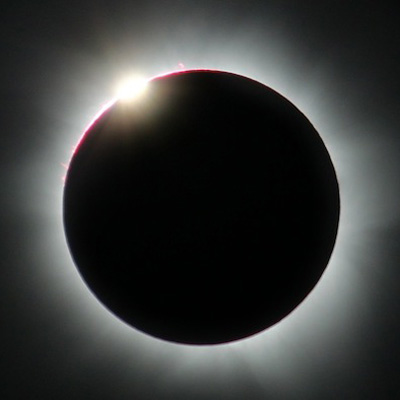
9. Are all total eclipses the same?
No, during solar maximum the corona is brighter and is more symmetric. There may be more prominences (red loops on the edge shining in Hydrogen-alpha light). The photo below shows the coronas from two eclipses, one near solar maximum (2012) and one near solar minimum (2009) photo courtesy Ken Offit, Australia 2012. During solar minimum, the corona has more extended structures near the solar equator and coronal holes with nearly vertical magnetic field lines near the poles.

10. Are solar eclipses safe to view with the naked eye?
NO! Solar eclipses are DANGEROUS except for the lucky ones in the path of totality, and only while the eclipse is TOTAL - ONLY THEN is it safe to view with your naked eyes, binoculars, and telescopes. Never point a telescope or binoculars towards the Sun unless it has a special filter on the FRONT (sun-side), not just over the eyepiece. For partial or annular solar eclipses, you have to use special eye protection or special camera filters. You can use pinhole projection, special "eclipse glasses", or welder's glass #14. Click here FOR the NASA website on safe observing. Safe, but silly, eclipse glasses are demonstrated in photo below from 2010.

The reason why eclipses are more dangerous than just looking at the Sun on a normal day is that your blink reflex doesn't work as well when the sky is dark – the partially eclipsed Sun seems darker but each uncovered piece of it is just as bright as normal and can burn an image of the crescent sun on your retina, especially if you are looking through a telescope or binoculars! Eclipses are NOT hazardous to pregnant women, despite customs in some societies.
11. Where should I go to see a total eclipse?
If you haven't ventured to a total solar eclipse, go if you can – it is one of nature's most wonderful marvels! There are many tours that specialize in eclipses: http://www.eclipsetours.com is the one I am frequently the science advisor on. There is a website just for American eclipses at http://www.greatamericaneclipse.com/
